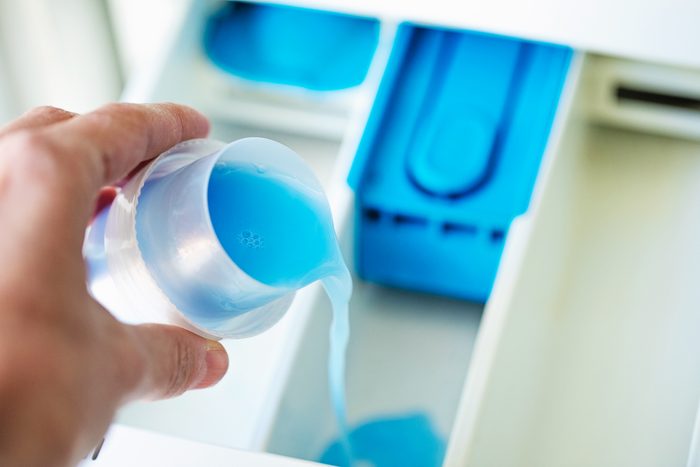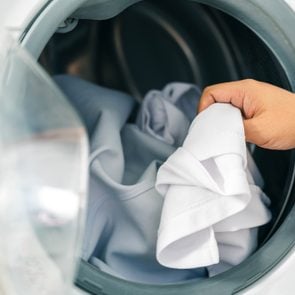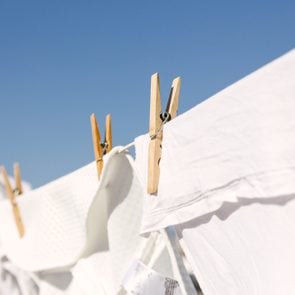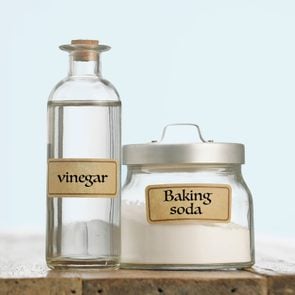How to Use Fabric Softener for the Coziest Clothes and Linens

Once you learn what fabric softener does and how to use fabric softener, you'll feel the difference in your laundry.
Our editors and experts handpick every product we feature. We may earn a commission from your purchases.
Although it’s become an everyday staple, fabric softener may be the most misunderstood laundry product of all. We assume, because of its name, that it will make our clothes feel soft. But, really, what does fabric softener do, and why should we use it?
“Unlike the best laundry detergent, fabric softener is a preference, not a necessity,” according to Annette Grant and Sarah Karakaian, hosts of the “Thanks for Visiting” podcast, who have tackled thousands of loads of laundry as short-term rental managers for more than a decade. “You certainly don’t have to use it, but if used properly, it does have a lot of benefits.”
Fabric softener can actually help prevent pilling on clothes. Want to know how to get wrinkles out of clothes or how to get rid of static? You guessed it: Use fabric softener. And like baking soda and vinegar in the laundry, which help break down bad odors, fabric softener can make clothes smell extra fresh.
What is fabric softener?
In short, it’s a product that contains lubricating ingredients that coat your fabrics’ fibers. This gives your clothes that coveted fresh-from-the-laundry feel.
Fabric softener is available in a variety of different forms, but all are comprised of positively charged ions that coat your fabrics. “These positive ions then attach themselves to the negative ions found on the ends of the fabric, making them stand up and feel softer to the touch,” explains Grant.
What does fabric softener do?
In addition to softening clothes and linens, fabric softener can also help reduce or eliminate wrinkles, lessen static, and prevent pilling (you know, those little balls of collected fabric that make your shirt look less than new). Plus, certain forms (liquid and powder) can protect your clothing, bedding, and laundry items from stretching.
And then there’s one of the major reasons people opt for fabric softener: If you choose a scented product, it will make your laundry smell fresh and clean.
Common fabric softener mistakes
Many people believe that fabric softener is a must when it comes to getting smells out of clothes, but as Grant and Karakaian pointed out, that’s a misconception. Fabric softener isn’t necessary, and it’s not going to get your clothes cleaner.
It may come as a surprise, but fabric softener really isn’t meant for everything you own. In fact, using it on certain items may make them less effective in the long run.
“The biggest mistake is using fabric softener on towels,” says Karakaian. “People think it will just make them fluffier—which it will!—but it will also reduce their absorbency. You have to decide which is more important to you.”
The same is true for workout clothes made of fabrics that have moisture-wicking properties. What does fabric softener do to these items? While it may make them smell better, it will eventually reduce their effectiveness.
If you have sensitive skin, you may want to avoid fabric softener. It can contain certain chemicals that may irritated the skin of some people. Instead, choose from among the best laundry detergents for sensitive skin and leave it at that.
When to use fabric softener
Lots of people use fabric softener simply because of the fragrance it provides, and there’s nothing wrong with that. There are so many different scents available, and as is the case with the best-smelling laundry detergents, a whiff of your favorite fabric softener can make your laundry feel complete.
Other people pour fabric softener into the load of laundry because they want a super-soft feel to the fabrics. And who doesn’t want to make like Snuggle the bear—the adorable mascot of Snuggle fabric softener—and breathe in a warm, freshly scented, fleecy towel? If you don’t want fragrance (for instance, if you have somewhat sensitive skin), you can always use an unscented version if you prefer.
“Outside of our short-term rentals, where it gives our linens a homey feel, we like to use fabric softener on our everyday clothes, anything cotton, and on our bedding,” says Grant. “It makes T-shirts, sheets, and pillowcases feel especially cozy.”
When shouldn’t you use fabric softener? When you’re washing water-repellent fabrics (think running tights or gloves with Gore-Tex), any items meant to absorb water or sweat (like workout clothes), and, for safety reasons, flame-retardant garments (think children’s pajamas).
How to use fabric softener
At this point, “What does fabric softener do?” may be a less-pressing question for you than “How on earth do I use it?” We get it. It can be hard to know when to add fabric softener (before you hit start, or midway through a load of laundry?) and exactly where in the washing machine you’re supposed to put it.
For the best results, Grant and Karakaian recommend the following steps when using fabric softener:
1. Read. Always read the instructions on the specific product you’re using, and be sure to check the care labels and laundry symbols that are found on the items you’re washing.
2. Measure. Following the instructions on the packaging, measure out the correct amount of liquid or powder fabric softener.
3. Pour. Here’s when to add fabric softener. Pour it right into the washing machine’s built-in dispenser. It’s important that you add it to the right place; if fabric softener isn’t diluted, it can stain your clothes. Your machine’s built-in container will automatically add it to the water before it meets your load of wash. Where you pour the fabric softener depends on your washing machine type:
- For front-loading washers: It’s likely a compartment in the drawer you pull out to add your detergent. Pour in fabric softener at the same time as you add detergent and before you start your wash cycle.
- For top-loading washers: The fabric softener dispenser is usually located in the center of the agitator—the tall cylinder standing in the center of the machine. Do not add softener directly into your washing machine’s drum! If you do that, it won’t be diluted before touching your clothes.
If you opt for dryer sheets instead of liquid softener, just toss one in the dryer with your load before you start the cycle.
Liquid vs. powder vs. dryer sheets
Fabric softener comes in different forms. The most common are liquid fabric softeners, powder fabric softeners, and dryer sheets. (Yes, dryer sheets and liquid softener do the same thing!)
“The main difference is simply which part of the laundry cycle you use. The sheets go in the dryer. The other two go in the wash,” says Karakaian. “While we do not use powder softener—just a matter of personal preference—we do use liquid fabric softener and dryer sheets daily, depending on what we’re washing. Dryer sheets are much more convenient and are an easy way to refresh textiles.”
If you’re swayed by the ease of what dryer sheets do, know this: “They don’t protect garments from stretching like liquid or powder fabric softener does,” Karakaian says.
She also suggests trying wool dryer balls, which help dry your clothes much faster, and adding three to four drops of essential oils to them for a fresh scent.
The best way to soften fabrics on a budget
If your decision between liquid, powder, and sheet softeners is a matter of cost, dryer sheets are your friend. The best dryer sheets are less expensive than the other fabric-softening options. But there are even cheaper ways to get fresh laundry.
“Keep in mind that good old-fashioned white vinegar and baking soda are just as effective as liquid fabric softeners and contain no toxins,” adds Grant. “Plus, they help reduce soapy residue from your washing machine and your plumbing pipes—that’s a win-win-win! Not to mention, buying vinegar and baking soda in bulk would make this option much cheaper than buying fabric softener.”
Grant and Karakaian personally recommend Downy and Snuggle products. Every four to five loads, they’ll use vinegar and baking soda instead. “Between our parents using these products for more than 45 years and us using them for the past 11 years, they are brands we know, like, and trust,” Grant says. “They never fail.”
Sources:
- Annette Grant and Sarah Karakaian, short-term rental managers and cohosts of the podcast “Thanks for Visiting“








